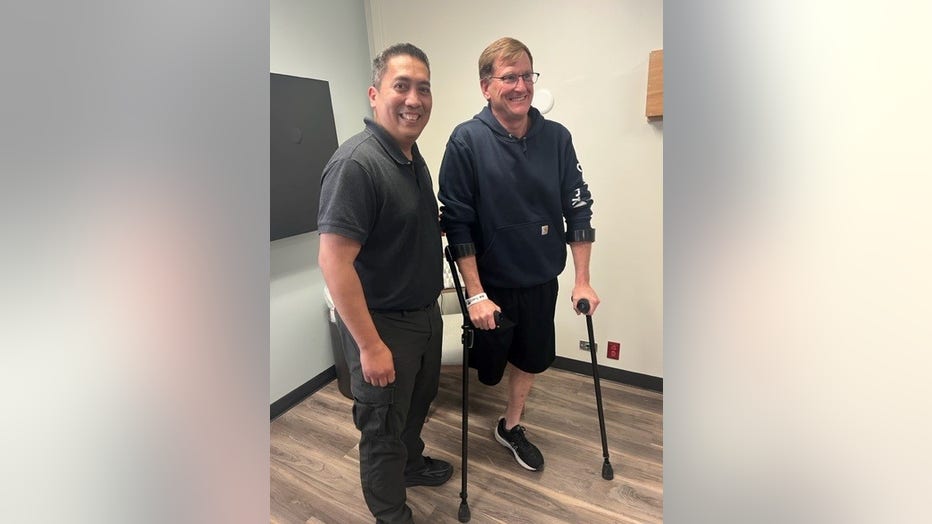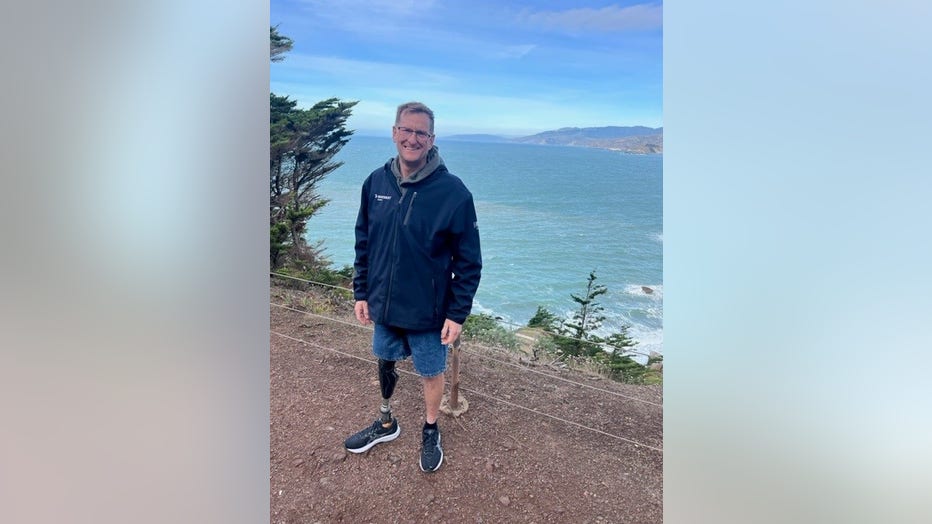Innovative prosthetic limb surgery piloted at San Francisco VA medical center
Innovative prosthetic limb surgery piloted at San Francisco VA clinic
April is Limb Loss Awareness Month. A first-ever two-part procedure known as osseointegration was piloted at the Veteran’s Affairs Health Care System in San Francisco.
SAN FRANCISCO - April is Limb Loss Awareness Month. A first-ever two-part procedure known as osseointegration was piloted at the Veteran’s Affairs Health Care System in San Francisco.
The procedure involves a two-part surgery that provides a mechanism for the direct skeletal attachment of an artificial limb to the residual limb of a person with an amputation.
The new innovative procedure eliminates the need for a socket, which is what traditional prosthetics use. Compared to socket suspension techniques, direct skeletal attachment of a prosthetic limb allows a patient to have a more natural feel and control of their prosthetic limb, improving balance, weight-limiting technology, and ease of use.
Douglas "Doug" Mayo is a U.S. Air Force veteran. He’s used a prosthetic leg that attaches above his knee for seven years now. He’s had multiple surgeries after suffering from several issues with his right knee.
Mayo said, "They did knee replacements which failed. They became infected. Thirteen surgeries and three years later, there weren’t any antibiotics that would treat the infection. So, I had a choice. My choice was pretty easy. The leg is not that important. So, they took my leg."
After serving in the Air Force, Mayo returned home to Nebraska. He is now married with five adult children, and he owns and runs his own cattle farm despite his disability.
He admits his work is tough, and he’s managed it through the years. He said, "I guess my biggest fear, when I had to choose amputation, was I wouldn't be able to do things I was able to do (previously). And that's not my biggest fear. My biggest fear was that I was going to be a hindrance to people. I didn't want people to do things for me."
When he researched a new program that included an implanted device, he was immediately on board. Osseointegration is a two-surgery procedure that could help with his pain, improve his mobility, balance, and provide more independence.
The first surgery is very invasive where a post is installed. Then six months of healing and recovery along with intensive physical therapy. Six months later, a second surgery is performed to position the new limb onto the implanted post. That surgery also comes with more rest, recovery, and physical therapy.
But for Mayo, osseointegration provides hope.
He said he knows that "when this is done, I’m going to be able to walk easier, walk better, have a better perception of what I’m stepping on. I'm going to be able to take a shower with my leg on."
It’s freedom of sorts for Mayo. Less pain, less skin irritation, better control, and more autonomy.

Ronald "Ron" Feliciano is a physical therapist and amputation coordinator at SF VA Health Care -who has worked with Douglas "Doug" Mayo (Alice Wertz)
"Now, I can help my dogs, help my wife, or anybody else. I can help them now. Before I had crutches, they'd have to help me out. And that's not me. So little things in life are going to be excellent. It's not going to be perfect. It's not a real leg prosthesis still, but I’m good with that," he said.
Mayo’s physical therapist is also the amputee program coordinator at the San Francisco VA Health Care System. Ronald Feliciano said Mayo’s great attitude makes him a model patient, and he’s confident he’ll be successful when it’s all done.
Feliciano said, "Doug is really great. The thing about him is, he’s a really, very active person. We really encourage patients to get moving. But I'm doing the opposite. He's doing more, and I’m saying, "Whoa! Slow down. Take it easy, Doug. We want you to really do well."

Air Force Veteran Douglas Mayo - the first to pilot osseointegration surgery (Douglas Mayo)
The Chief of Staff for the health care center, Dr. Bruce Ovbiagele is hopeful this pilot will be offered to other veterans.
He said, "It’s actually a game changer for many of our esteemed veterans. They are really able to enhance their quality of life and also able to ambulate much better, so this really supports an active lifestyle for our veterans."
For Mayo, he’s grateful to the doctors, the staff, and the VA health care system for their modern, innovative approach to patient care.
"Don’t hesitate. Have faith in the VA. It’s not like it used to be," he said.
Alice Wertz is a freelance reporter for KTVU Fox 2 News. She can be reached at Alice.Wertz@Fox.com

